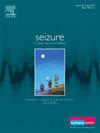伴有失神性发作的口周肌阵挛的临床和脑电图特征
IF 2.8
3区 医学
Q2 CLINICAL NEUROLOGY
引用次数: 0
摘要
目的探讨缺缺型口周肌阵挛(POMA)患者的临床、电生理特点及治疗预后。方法从脑电图数据库中选择POMA患者。收集的数据包括详细的临床信息、VEEG特征和脑MRI结果。先前报道的POMA患者也被筛选纳入研究。结果共纳入19例患者。癫痫发作的中位年龄为5岁(范围2 ~ 11岁),男性占84.2%(16/19)。73.7%的患者在清醒和睡眠期间均有VEEG监测POMA, 63.2%(12/19)的患者可由过度通气(HV)诱发。同步口周肌电图证实初始3-Hz放电与肌阵挛性抽搐时间锁定。12例患者接受VEEG随访,66.7%的患者通过丙戊酸钠(VPA)单药治疗实现无癫痫发作。回顾先前对15例POMA患者的报道,发现66.7%的患者为男性。5例患者使用奥卡西平(OXC)、卡马西平(CBZ)或苯妥英后癫痫发作加重。结论poma癫痫虽罕见,但仍有其独特的特点。POMA更常发生在男性身上。73.7%的患者在清醒和睡眠时均有POMA。VEEG背景基本正常,在急性期有节律性的3hz广泛性峰波放电,与口周肌阵挛时间锁定。POMA患者对VPA反应良好。POMA可能被误诊为局灶性癫痫发作,但应避免使用OXC、CBZ和苯妥英钠进行治疗。本文章由计算机程序翻译,如有差异,请以英文原文为准。
Clinical and EEG-EMG characteristics of perioral myoclonia with absence seizures
Objective
This study aimed to explore the clinical and electrophysiological characteristics and treatment prognosis of patients with perioral myoclonia with absence (POMA).
Method
Patients with POMA were selected from our EEG database. The collected data included detailed clinical information, VEEG characteristics, and brain MRI results. Previously reported patients with POMA were also screened for inclusion in the study.
Result
Nineteen patients were included in the study. The median seizure onset age was 5 years (range, 2–11 years), with 84.2 % (16/19) of the patients being male. POMA was VEEG monitored in 73.7 % of the patients during both wakefulness and sleep, and 63.2 % (12/19) could be induced by hyperventilation (HV). Synchronized perioral electromyography confirmed that the ictal 3-Hz discharge was time-locked with the myoclonic jerks. Twelve patients underwent VEEG follow-up, with 66.7 % achieving seizure-free with valproate (VPA) monotherapy. A review of previous reports on 15 patients with POMA revealed that 66.7 % of patients being male. Five patients experienced worsening of seizures with oxcarbazepine (OXC), carbamazepine (CBZ), or phenytoin.
Conclusion
POMA epilepsy, although rare, still presents distinctive characteristics. POMA tends to occur more frequently in males. 73.7 % of the patients had POMA during both wakefulness and sleep. The VEEG background is mostly normal, with rhythmic 3-Hz generalized spike and wave discharges during the ictal period that are time-locked with perioral myoclonia. Patients with POMA respond well to VPA. POMA may be misdiagnosed as focal seizures, but the use of OXC, CBZ, and phenytoin sodium for treatment should be avoided.
求助全文
通过发布文献求助,成功后即可免费获取论文全文。
去求助
来源期刊

Seizure-European Journal of Epilepsy
医学-临床神经学
CiteScore
5.60
自引率
6.70%
发文量
231
审稿时长
34 days
期刊介绍:
Seizure - European Journal of Epilepsy is an international journal owned by Epilepsy Action (the largest member led epilepsy organisation in the UK). It provides a forum for papers on all topics related to epilepsy and seizure disorders.
 求助内容:
求助内容: 应助结果提醒方式:
应助结果提醒方式:


